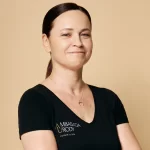Manual therapy is the restoration of reversible disorders in skeletal muscles, joints, skin, subcutaneous tissue, fascia and nervous system. The cause of functional changes are primarily disorders of normal posture and movement. This occurs under the influence of improper posture during daily life, repetitive faulty motor actions, and bad form of breathing as well as injuries, surgeries, increased mental tension and constant stressful situation. Stress is often the first step in the chain of functional changes. Living in constant tension, fatigue, anxiety, causes a defensive posture. This leads to a constant static tension of certain muscle groups which in turn impairs the mobility of the joints that regulates the muscles. Disorder of movable joints, especially if these are joints of the spine, may then lead to pathological symptoms in all structures innervated from a blocked segment of the spine. In the area innervated from a locked segment, it leads to changes in texture and elasticity of the skin and also leads to formation of hyperalgesic zones and overly sensitive points. The study of soft tissue, known as layered study, is based on a very thorough assessment through palpation. The main task of the diagnostic studies is to find the first link in the chain of functional changes. Only when the source of disturbance is eliminated, it will lead to a cure.
IMPORTANT INFORMATION FOR PATIENT ABOUT THE MANUAL THERAPY
- The therapist, depending on the needs of the patient, uses various methods of manual therapy: Mulligan, Rakowski, a’Levite and McTimoney's chiropractic method.
- It is not aimed at producing cracks at the joints and often the desired effect is achieved using very delicate force.
- It is important for the patient to cooperate with the therapist because it will reduce the time of treatment. The patient himself will subconsciously know that the exercise is good for him and how it will bring him the desired results.
- If the patient with the help of a therapist knows the cause of his ailment, this information may in the future help prevent its recurrence.
Expert opinion

Craniosacral bioenergy therapy, especially in its biodynamic form, is an incredibly inspiring and effective approach for me as a therapist. It integrates precise anatomical knowledge with an energetic and process-oriented view of the body, which resonates perfectly with my experience working with tension, stress, and trauma.
In my practice, I have noticed that this form of therapy allows me to reach very subtle, often unconscious tensions in the body - ones that are not always accessible through manual work or traditional massage methods. Thanks to the biodynamic approach, where the therapist follows the organism's inner intelligence, deep work is possible, yet extremely gentle and respectful of the client's boundaries.
Although this therapy is not widely known in Poland yet, it is gaining recognition in international circles, especially those dealing with trauma. It is valued, among others, in Peter Levine's Somatic Experiencing approach, which also resonates with me in my work - particularly in terms of regulating the nervous system and supporting natural self-healing processes.
For me, craniosacral bioenergy therapy is not just a method - it is a way of being with another person, in mindfulness, trust, and readiness for whatever emerges.
